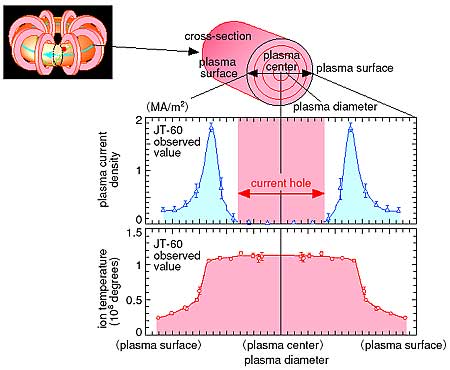By measuring the plasma current distribution precisely in the JT-60U tokamak,
we have observed for the first time a persistent "current hole" where
almost no toroidal current exists in the central plasma region, and also confirmed
under this particular current distribution a stable confinement of fusion plasmas
with temperatures higher than one hundred million degrees.
In a tokamak the plasma is confined in an infinite set of nested basket-like magnetic structure woven by twisted magnetic lines of force, the resultant of combined toroidal and poloidal magnetic fields, the latter being generated by a toroidal current in the plasma. The toroidal current in the center of the plasma is thus believed to be necessary for plasma equilibrium and confinement.
The fusion research on JT-60U has been centered on the development of a steady-state operation tokamak reactor by utilizing plasma self-generating bootstrap current. Since no current is induced in the center of the plasma due to the physics nature of the bootstrap current, an additional externally-driven plasma current such as beam-driven current or microwave-induced current has been necessary so far (Fig. 3-1).
Recently we have made a detailed measurement of the distribution of plasma current in the plasma center using an upgraded measurement system based on motional Stark effect diagnostics. A typical experimental result is shown in Fig. 3-2. The current hole remained stable for about five seconds and the plasma confinement was also stable and good during the presence of the current hole. From the observations the current hole itself is thought to be a stable structure formed by some kind of the bootstrap current-dependent self-organized processes. If we can well harness this mechanism in the future, it will be possible to sustain high performance fusion plasmas stably without externally-driven central toroidal current and reduce the cost of equipment and operation, leading to a more economical future steady-state tokamak fusion reactor. |

